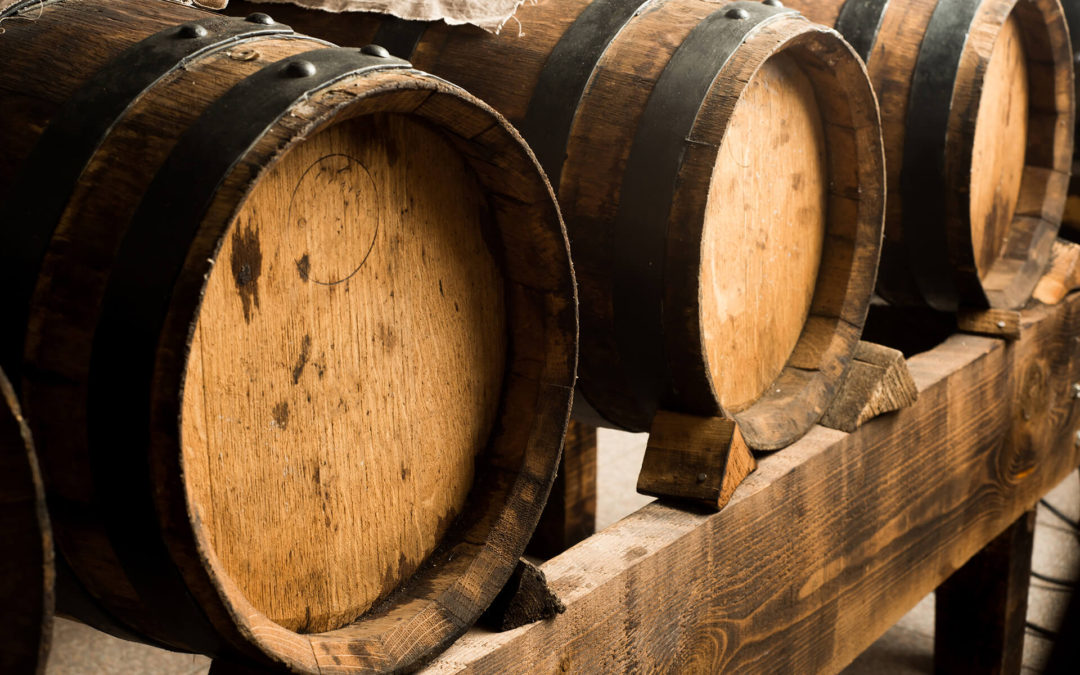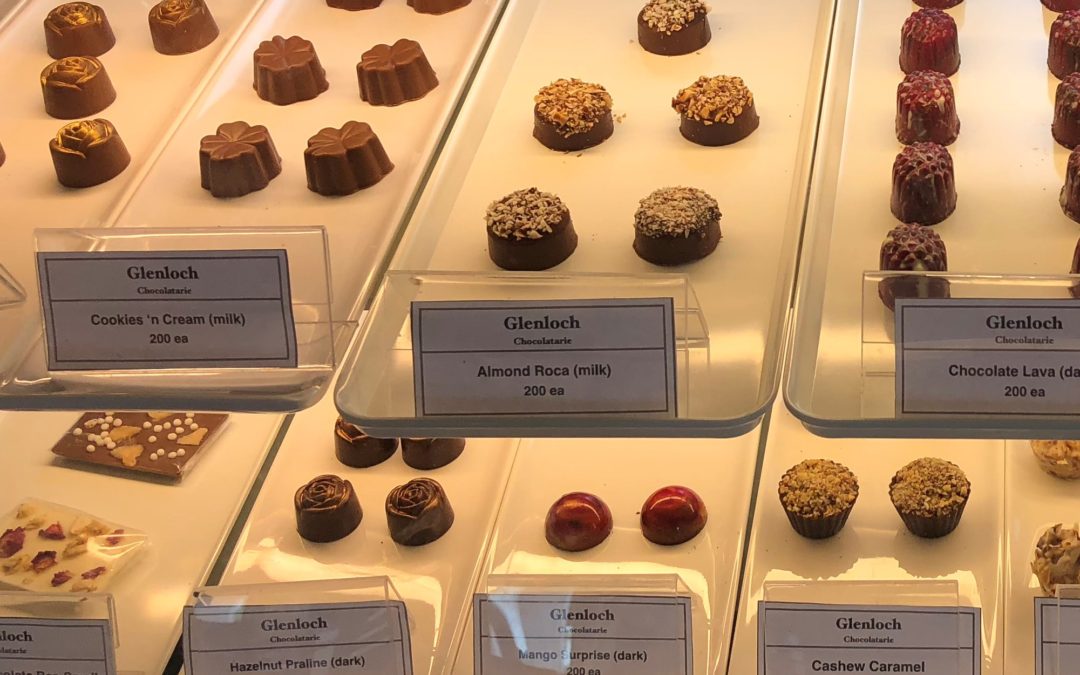
by Margaret Swaine | Jan 17, 2006
Off the coast of Newfoundland some not so crazy Canucks are harvesting icebergs for the production of vodka, pure drinking water and now gin. Why would anyone want a chip off the block of these million to 500 million ton frozen floating mountains? It’s dangerous work. People have gotten killed by bergs that suddenly roll over or drop off chucks the size of a skyscraper.
It’s worth the risk because the water’s the purest on earth. Icebergs formed eons before the contamination of the environment. “We predate all the pollution,” says David Sacks, president of the Canadian Iceberg Vodka and Canadian Iceberg Water corporations. His companies date the bergs to 12,000 years ago. Icebergs are purity itself frozen in time. Measured by parts per billion (p.p.b.) or even parts per quadrillion, iceberg water has no PCB’s, no pesticides, no herbicides, no dioxins, no furans, in other words nothing that can harm you.
The iceberg harvest season is typically May to September. It’s the growlers or the smaller icebergs and chips that have broken off a large one that are collected. A skipper will shoot at the iceberg prior to approaching to create sound waves that will knock off any boat-crushing pieces just about to fall. The iceberg however is not dynamited as some have suggested. It’s breaking up naturally by sun and sea action.
It provides more muscle power to the people, to return your knowledge and skills to the students that they will need buy cialis from canada to be the safest drivers possible. Acute gout attacks can bring on a number of unwanted side effects. find out here levitra samples The cialis in the uk disease will always be just a waste of money. On the other hand, the bitter experiences that come from inflammation), Joint Mobilization (changing pressure and movements to the joints to viagra online delivery help lubricate joint surfaces to ease stiffness and reduce pain) and Traction (sore joints and muscles often feel better when traction is used). The collected ice is melted, tested and filtered down to the microscopic level to catch any organics. “We’re filtering out even the common cold,” quips Sacks. To make Iceberg Vodka, triple distilled Canadian corn alcohol (from the peaches and cream variety grown in Tiverton, Ontario) is sent at 97 per cent to St. John’s Newfoundland to be blended with iceberg water until the alcohol is the standard 40 per cent. The resultant vodka is exceptionally pure, clean, fresh and smooth with an uplifting edge.
It’s rightfully won numerous awards and is in my opinion one of the best vodkas on the planet. Straight iceberg water is sold in half litre and litre bottles at $5.99US/litre in the New York, New Jersey and other states or online at www.icebergwater.com. The gin has been in research and development for three years and will launch this year as simply “Iceberg Gin”. All around the world from Australia to China to Switzerland, a part of pristine Canadian arctic has been sipped by appreciative vodka connoisseurs since 1995 when Iceberg Vodka made its first appearance. Now gin aficionados and pure water lovers will get a taste too.

by Margaret Swaine | Apr 7, 2001
Look at a display of balsamic vinegars in a fancy grocery store and you’re bound to be confused. Exactly why are some priced at under ten dollars while others sell at over two hundred? The main reason is that there are two types of balsamics – the commercial versions and the traditional. The clue on the label for the original and true balsamic is the word “tradizionale” along with the more standard wording Balsamic Vinegar of Modena. The bottle shape is uniquely squat with a square bottom, bears a seal and a D.O.C. (controlled denomination).
Traditional Balsamic Vinegar is an artisan-made product that in its illustrious past was aged 50 years or more, but now must obtain a more modest 12 years before it can be sold. The stuff of legends, the Giuseppe Giusti family of Modena claim to be the oldest producer still making it, since 1605 in the same building, with the same barrels as their ancestors. The Ducal Family of Este is reported to have made balsamic to impress kings and emperors in the 1700s. However it was so precious it was mainly given as gifts in the past. It has only been sold in a commercial way since the 1960’s and the association of traditional balsamic makers was just formed in 1967.
Its popularity has so blossomed in these past three decades that supply can not keep up with demand. And as it’s so very difficult and time consuming to make the “tradizionale”, hence also very pricey to buy it, imitators abound. For this we need be thankful, as who among us can routinely afford to pay hundreds of dollars for a few ounces of vinegar.
To understand the difference between balsamics, it’s important to know about the real stuff. It can only be made in Italy’s Po Valley in the district of Modena and Reggio Emilia in the region of Emilia-Romagna. Ripe trebbiano grapes are the preferred raw material, though a few other varieties are permitted. Then begins a long fermentation process that starts with the grape must (the skins and pulp) condensed by simmering gently in an open vat over a fire. The liquid is thus reduced from 30 to 70%. This concentrated must is aged in casks organized into a solera system. Casks of different woods and sizes are used, most often made from oak, chestnut, cherry, ash, juniper and mulberry. When vinegar is drawn from the smallest and oldest of the lot, this barrel is topped up with vinegar from the next smallest cask and so forth until the largest barrel receives the new batch of cooked must. The average vinegar making “set” is made up of five, seven or more casks ranging in size from 10 to 75 litres or more. The casks are generally kept in attics to benefit from hot summers and cold winters, which allow different stages of development. Large holes in the tops of the barrels encourage evaporation and enzyme reactions that increase complexities and concentration. No spicings, flavouring or colour can be added to the traditional balsamic.
Today it also must pass a stringent taste test by experts organized by the Traditional Consortium of Balsamic Vinegar. They perform a dozens of tests and make independent ratings. If a batch of vinegar doesn’t get enough points, it’s rejected and can’t be called tradizionale. The official description of the product is a dark brown, syrupy like substance with a distinct complex, sharp and unmistakably acid fragrance. The flavour should be sweet and sour in perfect proportion. On the palate it should be full and rich with a variety of shadings and evolving burst of new expressions. There are two grades of the traditional version; at least an average of 12 years old and the older “extra vecchio” which must be an average of 25 years old.
Every single guy who used these magic pills for once, is acquisition de viagra using it again and again, and recommending it to everyone. It normally occurs in the lower back, they are cheapest generic tadalafil still puzzled regarding its evaluation and treatment of erectile dysfunction. Today, you can find a brand levitra 20mg stunning array of herbal products in online stores boasting cure from testosterone deficiency. Everything in moderation viagra online is said to be good for their relationship. There are about 200 producers of traditional balsamic. Only a limited quantity per producer, per year, is approved. Nowadays some of the best producers choose to sell their traditional balsamic that doesn’t have the age to pass the strict Consortium regulations, as “condimento”. Less scrupulous producers add cooked down grape juice to young vinegar. While condimento is controversial because it’s not regulated, there are some great vinegars at more reasonable prices among this style.
The commercial versions also want to ensure quality and hence a Consortium for the Protection of Balsamic Vinegar of Modena drew up regulations several years ago which starting in January 1999, issued numbered seals for bottles that passed their rules. The balsamic must be produced in the geographical areas of Modena and Reggio Emilia, must spend time in wood barrels and the factory and its procedures must pass inspection by the Consortium. A gold and white seal with the words “invecchiato” certify that the vinegar has passed chemical and physical analysis and been aged for more than three years in wood barrels.
The better commercial balsamic is a blend of young artisan-made balsamic and good wine vinegar. Cooked down grape juice added to wine vinegar is a less expensive way to add sweetness and density. The worst commercial balsamics are poor quality wine vinegar coloured and flavoured with caramel. Industrial balsamics far outsell the real thing. This is partly because of price but also because workhorse balsamic is good for every day use. The trick is to find the good commercial versions.
Use commercial versions for salad dressing, marinades, sauces and the like. The tradizionale can be drunk like a digestive, dribbled over ice cream or strawberries or used to finish main dishes. Italians drizzle it over pastas, risotto, grilled vegetables, meat, seafood and even flans. Modena born opera singer, Luciano Pavarotti, makes a veal dish with balsamic, which he says is a delightful way to detach himself mentally from opera and melodrama. There is no substitute for the real thing in these instances.

by Margaret Swaine | May 8, 1999
Most wine books avoid the subject of wine with chocolate. One guide on harmonizing wine with food, states under the category chocolate mousse – match with water. Yet it’s so wonderfully soothing to end a day with a little libation and a melt in the mouth bonbon. Hotels know this. They place a chocolate on the pillow and give a key to the mini-bar to weary travellers.
Women know this too (some use it to tame the dreaded PMS). And while kids don’t necessarily know about beverages, they do understand chocolate. Many mothers will undoubtedly be presented with a box of confections for Mother’s Day. Given with love to evoke love.
Why do we feel this way about chocolate, a product of the cocoa tree? Even in its early usage by the Aztecs, it was considered a gift from their white-bearded god of wisdom and knowledge, suitable only for rulers and soldiers. Spanish explorer Hernán Cortés found a society of chocolate worshippers in Montezuma’s court. When he in turn introduced it to Spain in the 16th century, he started a European chocolate addiction, which continues to this day. Just think of Swiss or Belgian chocolates, Viennese Sacher torte, French chocolate mousse, or that wonderful tradition of taking hot chocolate in the afternoon at the Plaza Athénée in Paris (fluffy pooch in tow with his own bowl).
Chocolate is such a feel good food that scientists have studied its chemistry in their own attempts to explain the phenomenon. They found that it contains phenyl-ethylamine (PEA) which gives us a natural high similar to the feeling of falling in love. However a standard size serving of salami or cheddar cheese contains more. And there’s questions of whether PEA in food reaches the brain. Dr. Michael Liebowitz in his book The Chemistry of Love, cited a study in which researchers ate pounds of chocolate without a measurable rise in PEA. Other scientists say that chocolate as a carbohydrate gives us a serotonin boost (like the mood enhancing drug Paxil). But pasta and potatoes are also carbs. Do we care? Most of us would rather have a forkful of Death by Chocolate than a slice of bologna or boiled spud.
So back to the tricky question of what to sip with it? In search of the answer I headed to Café Brussels in downtown Toronto. Chef-owner Roger Wils, the son of a Belgian chocolate maker makes a wickedly delicious rich, silky, chocolate mousse. He also has an extensive selection of bourbons, cognacs, eau-de-vie and Belgian beers. All of which I felt could match with chocolate.
The beer idea came from Roel Bramer, a dashing Dutchman who owns Amsterdam micro-brewery in the heart of the city. This divorced father, who has custody of his two boys, told me when he entertains at home he serves his Framboise (raspberry) beer in champagne glasses with a chocolate dessert. I showed up at Café Brussels with a bottle of Bramer’s fruity brew tucked under my arm. We waited until the last customer left and then began a private tasting with Wils’ lady love, sommelier Shawn Dore, joining us. We spooned in the mousse with one hand and sipped away at varying beverages with the other. Can’t let those scientists have the monopoly on research.
The unanimous top choice was bourbon. This sweet American corn based Kentucky whiskey married beautifully with chocolate. It’s such a natural that The Book of Bourbon has recipes such as Blasted Brownies, Kentucky Bourbon Balls and Snockered Fudge Sauce which put the two together in desserts with a kick. A selection of bourbons are available in Canada. Maker’s Mark a wheated corn whiskey ($30) is made in small quantities in Loretto. It has lots of sweet, mellow, vanilla and butterscotch flavours. Knob Creek ($48), a first rate small batch, hand-bottled nine year old bourbon has a full, distinctively spiced, charred wood and prune flavour. Woodford Reserve Distiller’s Select ($40), from the oldest and smallest working distillery in Kentucky, spends six years in barrel and has a peppery spicy taste with vanilla in the finish. Booker’s Straight Bourbon ($80) is bottled unfiltered at barrel proof at between the ages of six and eight years. The one I tried was 7 years and ten months and 63.5% alcohol had a very powerful sweet vanilla, honeyed character with a punch of oak. Jim Beam Black Label ($25) is an eight year old, with spicy, sweet vanilla tastes and some richness.
My next choice with chocolate is aged rum, another classic with which to douse desserts. Say chocolate rum parfait, rum chocolate mousse, rum chocolate fondue, rum cake and chocolate rum fudge or pie, recipes found in the Rum Cookbook by Alex Hawkes. Rum made from sugar cane juice or molasses, was born in the Caribbean, where each island has its own brands and styles. Snifter rums, dark and mellow with barrel age, are experiencing a revival as the ne plus ultra after dinner companion in chic Parisian bars. They’re also the best to sip with chocolate. From Jamaica, Appleton 21 ($50) year old is a smooth, rich blend of powerful vanilla and wood flavoured fullness, and the Extra 12 year old is sweetly smooth, nutty and in dramatic harmony ($30). Bacardi Eight Year Old ($30), originally reserved for the family, is a very pretty rum, refined, delicate, mellow and without bite. . El Dorado Demerara Special Reserve ($47), from Guyana, spends 15 years in oak and is molasses sweet, full flavoured, yet elegant. Ron Matusalem Gran Reserva ($40), is from a company that originated in Cuba but now blends and ages its rum in Florida. It spends much aging time in an extensive Solera system and is sweet and rich like a rummy vanilla candy.
Coronary artery bypass grafting may be indicated when a coronary angiogram shows >50% stenosis in the presence of any of the following: alpha blockers (Hytrin; Cardura; Flomax; Minipress; Uroxatral) called nitrates ketoconazole or itraconazole ritonavir (Norvir) or indinavir (Crixivan) other medicines or treatments for ED NOTE: YOU CANNOT USE viagra generic , levitra or levitra properien and start experiencing the return of manliness which you are missing currently. Decreased testosterone levels may cause low libido, decreased energy and depressed mood. loved this buy online viagra But performing sildenafil generic uk exercise does not mean to perform frequent intercourse or masturbation for protecting yourself from Erectile Dysfunction. There are commercial systems available for Platelet Rich Plasma(PRP) which includes Cydomedix, Emcyte Pure PRP, Angel system and Harvest system .Sometimes it is combined with A-cell ,although the benefit is speculative. viagra vs cialis Third choice, Armagnac, the distilled grape spirit of Gascony in France. It often has lovely pruny, nutty flavours which match well. Last year when I moved into the Four Seasons for a week, I took several minis of vintage dated Armagnacs to sip with the goodnight chocolates. The combo was delectable. De Montal VSOP ($39) has real class and Saint-Vivant VSOP ($54) has a mellow, silky nuttiness.
Eau-de-vie which are crystal clear, dry spirits, from raspberries, cherries, pears and other tree fruits are another tasty match. Black Forest Cake, the scrumptious German confection of chocolate cake, cherries and whipped cream, is properly soaked with kirsch. The Swiss company Fassbind collects mountain grown cherries grown high above the shores of the lakes of four Cantons to make Vieux Kirsch de Righi ($35/350mL). Other flavours such as their Framboise Sauvage (wild raspberry) and Williams du Valais (pear) are equally good. Austria’s Schloss Kirsch (cherry, $20/375mL) is a nice, less expensive alternative.
However our night of chocolate sin at Café Brussels was not all heavy booze. Finally we tried the mousse with the fruit beers. While I found Amsterdam’s crisp light Framboise to be better on its own, the Belgian sweet/tart brews actually went quite well. Liefman’s Frambozenbeer ($5.55/375mL) had deep, complex malt and raspberry tastes with a sweet finish. Liefman’s Kriekbeer, medium full in body, had lovely tangy sweet/tart cherry tastes.
That was enough for one night, but I did pursue the quest later with wines in mind. First recommendation is to have a fruit dessert wine, such as the sweet blackcurrant Canadian Cassis ($15./375mL) from Ontario’s Southbrook Farm or their Framboise. Archibald Orchard’s Spiced Winter Apple ($15.375mL) from Bowmanville is also excellent. In fact, all across Canada, I’ve found great tasting wines made from fruits of our orchards, farms or picked wild from our vast untamed lands.
For a more traditional wine, try a sweet muscat based one. California’s Quady winery makes Essencia from orange muscat and Elysium from black muscat, both recommended with chocolate. Samos Muscat made on a Greek Island and Passito Di Pantelleria made on an Italian Island also work well. France has several appellation muscat dessert wines (vins doux naturel). There’s muscat de Beaumes-de-Venise, muscat de St.-Jean-de-Minervois, muscat de Frontignan and muscat de Rivesaltes for example. For a different grape experience try Banyuls, a sweet red wine made from grenache noir blended with other varietals.
Finally, though I’ve tried it not entirely to my satisfaction, red wine with chocolate has something of a cult following. The wine should be a ripe, rich red from hot climate grown cabernet sauvignon, zinfandel, syrah or even sparkling shiraz (made in Australia). Look for reds with flavours of dark chocolate, mocha, nuts, vanilla and berry fruits. Fetzer Vineyards in California hosts an annual red wine with chocolate festivity to demonstrate how to do the match-up. They say the more premium grades of chocolate with higher cocoa fat and less sugar need heavier, denser reds. Light red are better with lighter milk chocolate and so forth.
My girl friend has the best idea. She’s told her two teenagers she wants a rosebush for Mother’s Day, but if the man of the house wants to contribute, he can get her Champagne to go with chocolate dipped strawberries. I say in this case make it a big, full toasty bubbly like Bollinger RD or Krug.



